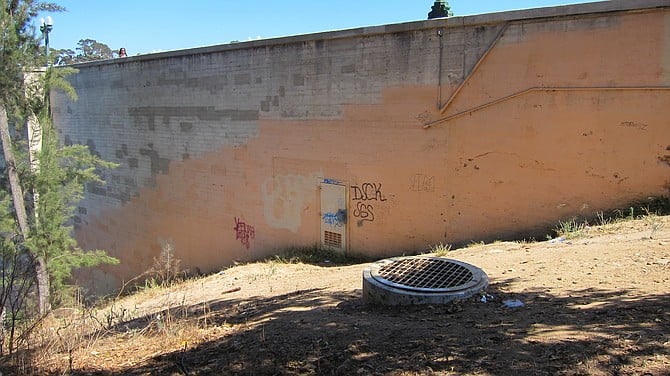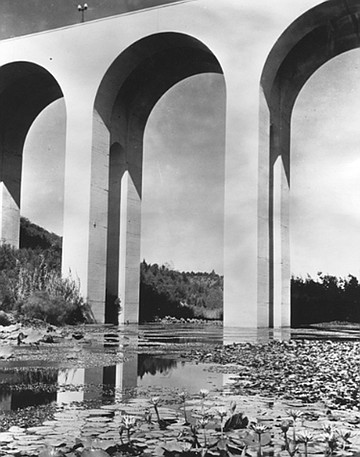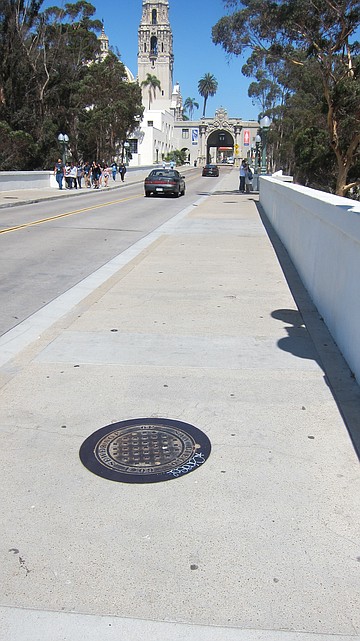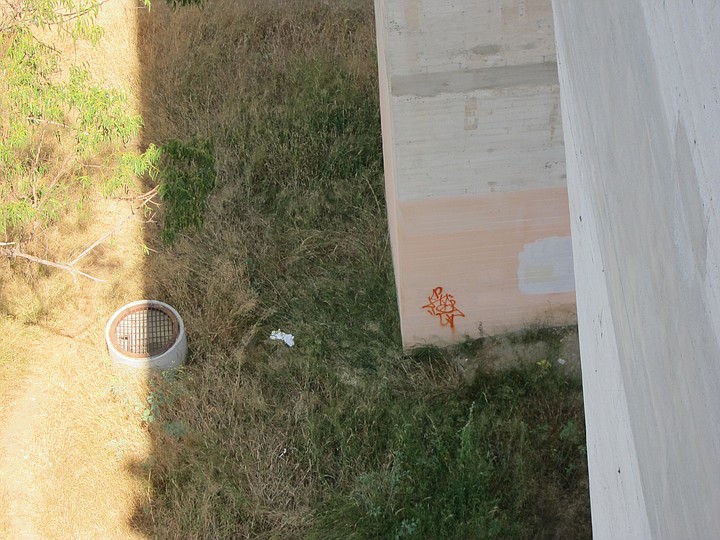 Facebook
Facebook
 X
X
 Instagram
Instagram
 TikTok
TikTok
 Youtube
Youtube

"We've had some transients living in the bridge," Balboa Park operations district manager Mario Llanos said last month. "They're going in and out of the manholes on the bridge, so I'm not sure what we can do about that."
While it wasn't a lengthy discussion at July's Balboa Park committee meeting, it was definitely noteworthy that transients are again making themselves at home inside the columns of a bridge originally designed as the entrance to the 1915 Panama-California Exposition.



Today, Cabrillo Bridge extends over a canyon and freeway, but in 1915 there was a lagoon down below. It was eventually drained circa 1940 to allow for the freeway. In 1975, the bridge was added to the national register of historic places.
I contacted Llanos the week following the meeting to discuss the situation. He forwarded me to Tim Graham, spokesman for the city's Park and Recreation Department.
I asked Graham when it first came to light that transients were living inside the bridge. "In late May, park rangers were notified by the Balboa Park visitor center that a member of the public reported seeing a person exiting a manhole on the bridge. Rangers began their investigation immediately after the notification."
Graham said the exact number of transients accessing the bridge isn't known but park rangers have spoken with at least 12 individuals. He said it appears most individuals are accessing the bridge through the abutment doors located at the base of the southeast side of the bridge along the 163 corridor. He said both the abutment doors and manholes lead into the interior of the bridge.
Investigations concluded that transients originally entering via the abutment doors have secured the doors from the inside — making manholes the only means of entry and exit.
"We have seen locks that have been cut from the outside, as well as transients trying to jam the door shut to seal it from the inside. In those cases, access through manholes at the top of the bridge would be the only way to get inside the bridge." He said there are a number of manholes that transients are using.
Graham said city staff are working in conjunction with Caltrans (which owns and maintains the bridge, except for the deck atop the bridge) to determine the best solution to keep trespassers from entering.
"Solutions could include changing the locks on the abutment doors and spot-welding the manholes so the covers can no longer be removed."
Graham said that potential damage to the bridge has been minimized as a result of a retrofit that replaced the original redwood support structure with steel and concrete.
"There were concerns that the original wood could catch fire, potentially damaging the bridge and trapping anyone who happened to be inside."
Graham said manholes not properly closed can become a tripping hazard; the city has no reports of this, he said.
I asked Graham to discuss the transient sweeps that Llanos mentioned at the meeting. He said that most of the sweeps take place in Florida Canyon (east of the zoo) and adjacent canyons within Balboa Park. He said to keep the park safe for everyone and in an effort to locate transients who may have a criminal record and/or suffer from mental illness, the park rangers coordinate with the police three or four times a month to identify potential hot spots. "[June's] Florida Canyon selective enforcement resulted in eight arrests and six field interviews over four separate evenings."
Graham said the city doesn't anticipate any transient-related issues impacting the proposed bridge bypass project. On August 9, it was reported that the proposed project overcame an environmental challenge from Save Our Heritage Organisation, but another lawsuit regarding the selling of bonds to finance it still needs to be heard.


"We've had some transients living in the bridge," Balboa Park operations district manager Mario Llanos said last month. "They're going in and out of the manholes on the bridge, so I'm not sure what we can do about that."
While it wasn't a lengthy discussion at July's Balboa Park committee meeting, it was definitely noteworthy that transients are again making themselves at home inside the columns of a bridge originally designed as the entrance to the 1915 Panama-California Exposition.



Today, Cabrillo Bridge extends over a canyon and freeway, but in 1915 there was a lagoon down below. It was eventually drained circa 1940 to allow for the freeway. In 1975, the bridge was added to the national register of historic places.
I contacted Llanos the week following the meeting to discuss the situation. He forwarded me to Tim Graham, spokesman for the city's Park and Recreation Department.
I asked Graham when it first came to light that transients were living inside the bridge. "In late May, park rangers were notified by the Balboa Park visitor center that a member of the public reported seeing a person exiting a manhole on the bridge. Rangers began their investigation immediately after the notification."
Graham said the exact number of transients accessing the bridge isn't known but park rangers have spoken with at least 12 individuals. He said it appears most individuals are accessing the bridge through the abutment doors located at the base of the southeast side of the bridge along the 163 corridor. He said both the abutment doors and manholes lead into the interior of the bridge.
Investigations concluded that transients originally entering via the abutment doors have secured the doors from the inside — making manholes the only means of entry and exit.
"We have seen locks that have been cut from the outside, as well as transients trying to jam the door shut to seal it from the inside. In those cases, access through manholes at the top of the bridge would be the only way to get inside the bridge." He said there are a number of manholes that transients are using.
Graham said city staff are working in conjunction with Caltrans (which owns and maintains the bridge, except for the deck atop the bridge) to determine the best solution to keep trespassers from entering.
"Solutions could include changing the locks on the abutment doors and spot-welding the manholes so the covers can no longer be removed."
Graham said that potential damage to the bridge has been minimized as a result of a retrofit that replaced the original redwood support structure with steel and concrete.
"There were concerns that the original wood could catch fire, potentially damaging the bridge and trapping anyone who happened to be inside."
Graham said manholes not properly closed can become a tripping hazard; the city has no reports of this, he said.
I asked Graham to discuss the transient sweeps that Llanos mentioned at the meeting. He said that most of the sweeps take place in Florida Canyon (east of the zoo) and adjacent canyons within Balboa Park. He said to keep the park safe for everyone and in an effort to locate transients who may have a criminal record and/or suffer from mental illness, the park rangers coordinate with the police three or four times a month to identify potential hot spots. "[June's] Florida Canyon selective enforcement resulted in eight arrests and six field interviews over four separate evenings."
Graham said the city doesn't anticipate any transient-related issues impacting the proposed bridge bypass project. On August 9, it was reported that the proposed project overcame an environmental challenge from Save Our Heritage Organisation, but another lawsuit regarding the selling of bonds to finance it still needs to be heard.
Comments